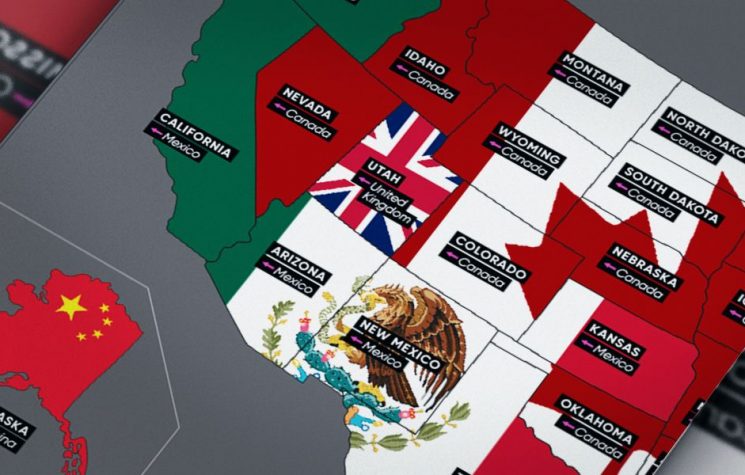In my last article, I discussed the new Post-COVID task force which is being spearheaded by Canada’s New Finance Minister Chrystia Freeland and her fellow Oxford technocrat Mark Carney in preparation for the upcoming COP26 Summit in the UK where it is hoped a Green New Deal may be unveiled as part of a Great Global Reset. In that location, it was made clear that Green Bonds play an important role in the financing of green energy grids which some technocrats hope will straddle the globe in order to reduce Carbon dioxide output to pre-industrial levels in an effort to reduce global climate by 1.5 degrees by 2050.
Echoing this agenda, creepy population control guru once known for his software-stealing savvy named Bill Gates stated on August 4 that “Some governments and private investors are committing the funding and the policies that will help us get to zero emissions, but we need even more to join in. And we need to act with the same sense of urgency that we have for COVID-19.”
The Devil in the Details
The problem with this reset isn’t that the orchestrators of this pending reform desire a new system of value beyond the “monetarist/anything goes” standards of free markets which have dominated our world under decades of globalization. We obviously need that since worshiping money on the unregulated markets just created a massive volatile bubble underlying a $1.5 quadrillion financial weapon of mass destruction called derivatives waiting to blow up.
The problem isn’t found in moving the nexus of economic regulation and planning back to governments which the Green New Dealers wish to guide the new world economic order. We obviously need that too, and the fact that the greatest rises in wealth and living standards historically occurred during periods when this sort of dirigiste approach was active should not be lost on anyone. If you have any doubts of this claim, then I refer you to Martin Sieff’s excellent analysis of Bismarck and the Failure of the UK’s NIS.
The problem is that the standards of value which proponents of the New Green New Deal believe we must re-allign our behavior to, have the peculiar characteristic of undoing human activity entirely under the guise of “monetizing the rate of reduction” of humanity’s carbon footprints.
This may seem paradoxical at first, but I ensure you this is exactly what is being sold to the credulous masses desperately seeking something new, stable and moral to guide our society out of the oncoming storms set to befall us. In order to get a visceral image of the tragedy: imagine a sick patient being convinced by a quack doctor that they need only endeavor to a little more bloodletting in order to be healed of their ills. Or imagine that an obese patient is told that their path to health is to be found not in proper eating and exercise but rather in contracting their belt size incrementally from a 48 inches to an 8 inch waist size.
This is what a world covered in windmills, solar panels, biofuels, green financing, and decarbonization will offer us.
Windmills vs Nuclear
Where it would take approximately 17 600 acres of land covered with windmills to produce about 1200 megawatts of power, the equivalent 1200 megawatts derived from nuclear sources would take up an area no larger than several city blocks. Quantitatively identical, the qualitative factor of difference of energy flux density of either source is even more dramatic. Where nuclear power can easily power a society’s industrial and consumer needs, a windmill farm’s energy output is of such a low flux density that it cannot even make another windmill.
While I am not a fan of the misanthropic undertones of Michael Moore’s Planet of the Humans, it did successfully demonstrate the total failure of green energy fantasies in a variety of ways.
Green bonds which would be issued through a mix of private banks and national infrastructure banks under a Green New Deal reset would be tied to long term large scale green infrastructure projects that would prohibit humanity from ever actually building the sorts of mega projects we once built during the days of the actual New Deal of the 1930s (ie: Tennessee Valley Authority, hydroelectric programs) or the current New Deal of the 21st century known as China’s Belt and Road Initiative.
The Real New Deal vs the Green New Deal
The reality is that the solutions for a real New Deal reorganization of today’s bankrupt world economy are available to us and would involve many of the mechanisms which Green New Dealers like Soros, Gates, Carney etc.. are proposing with one vital difference.
Rather than lower humanity’s productive powers of labor as the Green New Deal proposes, the new system of productive credit which must be created out of the ashes of the currently collapsing order should be premised upon:
1) A respect of national sovereignty under a win-win system of cooperation and NOT a system of supranational technocratic controls under the rule of a bankers’ dictatorship. This is the foundation of the multipolar alliance that Presidents Xi and Putin have defended for years and which an America freed of the likes of Pompeo and other China-bashing neocons may yet tap into.
2) Large scale, long term infrastructure projects which uplift the standards of living of all people, as well as the cognitive powers of all people and the productive powers of labor of all people simultaneously. To illustrate what this looks like, inspect the effects of the New Silk Road across Eurasia and Africa over the past 5 years.
3) That this process has the natural effect of increasing national capital and consumer consumption per capita and per square kilometer (since higher quality lives lived longer equates to higher rates and quality of consumption both individually and nationally). A viable modern guidebook to explore this system scientifically can be found in the writings of the late American economist Lyndon LaRouche with a focus upon his 1984 book So You Wish to Learn All About Economics and short accompanying video The Power of Labor.
Taken together, these three variables would tend towards an increase of humanity’s carrying capacity conditional upon the factor of something ivory tower mathematicians and computer modellers dominant in today’s econometric and climate science worlds detest: HUMAN CREATIVE REASON.
The Role of Creative Thought in Economic Systems
Abraham Lincoln understood this fact all too well 170 years ago when he said in 1860: “Man is not the only animal who labors; but he is the only one who improves his workmanship. This improvement, he effects by Discoveries, and Inventions.”
This idea was amplified by Lincoln’s leading economic advisor Henry C. Carey who said in 1872: “The more his power of association, the greater is the tendency toward development of his various faculties; the greater becomes his control of the forces of nature, and the more perfect his own power for self-direction; mental force thus more and more obtaining control over that which is material, the labors of the present over the accumulations of the past…”
If you haven’t noticed it, both Lincoln and Carey recognized that it is by increasing rates of discoveries of unknown organizing principles of the universe which allows our species to translate those new discoveries into greater rates of scientific and technological progress. This overcoming of our limits to growth by leaping to new technologies and resources would then establish a guiding framework for planning future investments into R & D with a focus on activities that push the frontiers of human knowledge with an emphasis on space exploration in the macrosmos and discovering the geometries of the atom (and the relationship of matter to energy) on the microcosmos.
This process embodied by Lincoln and Carey was once known far and wide as the “American System” and it isn’t a coincidence that EVERY SINGLE American president who died while in office (eight in total) were supporters of this system.
The Origins of the American System
During the crisis of 1783-1791, The newly established American republic was an agrarian economy in financial ruins with no means to pay off its debts or even the soldiers who fought for years in the revolutionary war. It was only a matter of time before the fragile new nation would come undone and be reabsorbed back into the fold of the British Empire.
The solution to this unsolvable crisis was unveiled by Washington’s former Aide de Camp and now Treasury Secretary Alexander Hamilton who studied the works of the great dirigiste economists like France’s Finance Minister Jean-Baptiste Colbert, and introduced a four-fold solution:
- Consolidate all unpayable state debts into a singular federal debt secured by the issuance of new bonds. This was done via his 1790 Report on Public Credit.
- Tie these new bonds to internal improvements like roads, canals, academies and industrial growth which would create a qualitatively new form of debt that would permit the nation to produce its way out of poverty which would lead to “the augmentation of the active or productive capital of a country”. In this sense Hamilton distinguished bad debt from good debt using the important guiding principle that the “creation of debt should always be accompanied with the means of extinguishment.” [to illustrate this more clearly: think of a farmer taking on a debt in order to feed a gambling addiction vs investing his loan into new farm supplies and a tractor.] The thrust of this conception was found in his Report on the Subject of Manufactures of 1791.
- Guide that new national power over finance by a system of national banks subservient to the Constitution and the General Welfare (instead of a system of central banks under the British model that ensured nation states would forever be subservient to the laws of usurious finance). This was illustrated in Hamilton’s 1790 Report on a National Bank and his 1791 On the Constitutionality of a National Bank.
- Use protective measures where necessary to block foreign dumping of cheap goods into the nation from abroad which essentially makes it more profitable to purchase industrial goods and farm products locally rather than from abroad. Hamilton also promoted federal incentives/bounties to encourage private enterprises to build things that would be in alignment with the national interests.
Throughout all of his works, Hamilton is clear that value is not located in land, gold, money, or any arbitrary value favored by followers of the British School like Adam Smith. In defending the growth of manufactures and internal improvements, Hamilton states that “To cherish and stimulate the activity of the human mind, by multiplying the objects of enterprise, is not among the least considerable of the expedients, by which the wealth of a nation may be promoted.”
The Overthrow of the American System
Although City of London-affiliated traitors in America like Aaron Burr established the speculative Bank of Manhattan which started Wall Street, killed Alexander Hamilton in 1804, and derailed many of Hamilton’s grand designs, the system was never completely destroyed despite the decades of attempts to do so. In 1824, the great German economist Frederick List came to America with the last surviving leader of 1776 Marquis Lafayette as part of an international effort to revive the sabotaged plans to create a world of sovereign republics modelled on the American experience of 1776.
While this effort failed with Lafayette’s supplication to the scheme of re-instating a French King in 1830 rather than declare himself the President (as I outlined in my recent paper on the Congress of Vienna), List studied Hamilton’s system and was the first to codify it as the American System of Political Economy (1827). This was the system which List transported to Germany by driving rail development, industrial growth, protectionism under the German Zollverein which finally blossomed under the rule of Chancellor Otto von Bismarck. List’s system was also studied, translated and applied in Russia by many “American System economists” with the greatest being the Transport Minister and Prime Minister Sergei Witte who oversaw the trans Siberian railway’s completion and envisioned a line eventually connecting the Americas to Russia via the Bering Straits.
In America, the clash between American vs British Systems defined all major conflicts from 1836 when a drunken racist named Andrew Jackson killed the 2nd National Bank (along with thousands of Cherokee) and brought the nation under the heal of British Free Trade, speculation, and cotton plantation economics. Following the IMF’s protocols that would be imposed onto victim nations 150 years later, Jackson cancelled all internal improvements in order to “pay the debt” and deregulated the banking system which resulted in the growth of over 7000 separate currencies issued by an array of state banks rendering the economy chaotic, bankrupt and prone to mass counterfeiting.
The defenders of the American System during this period (led by Whigs such as John Quincy Adams, and Henry Clay) played a rear-guard action hoping for an opening to occur at some point. When that opening finally arrived with the victory of Whig President William Harrison in 1840 a glimmer of hope was felt. Harrison swept to power with a mandate to “revive the national bank” and enact Clay’s American System of internal improvements but sadly the new leader found himself dead in a matter of only 3 months with legislation for the 3rd national bank sitting unsigned on his desk. Over his dead body (and that of another Whig president only 10 years later), the slave power grew in influence enormously.
It wasn’t until 1861 that a new president arose who successfully avoided assassination attempts long enough to revive Hamilton’s American System during a period of existential crisis of economic bankruptcy and foreign sponsored civil war which nearly destroyed the Union in ways not that dissimilar to the situation unfolding in America today.
In my next installment, I will introduce Abraham Lincoln’s revival of Hamilton’s American System with his incredible battle against the forces of Wall Street and the City of London who did everything in their power to ensure the success of the secessionist slave power.


































